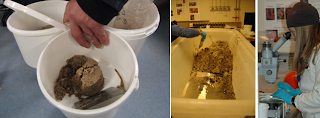Sediment is matter that has been deposited by some natural process on the seafloor. It can consist of mud, sand, gravels and pebbles and it may harbour high biodiversity. Its inhabitants range in size from a few millimetres to 45 micrometres (=0.045 millimetres) and are mainly tiny worms, crustaceans (like shrimps) and molluscs (like mussels).
There are different ways to collect sediments. Usually you core sample with a transparent plastic tube that you drive into the seabed which allows you to see the different layers.
In the vicinity of seamounts, the seabed is either too hard or sediments are too coarse to stay in the coring tube and we have had some unfortunate attempts.
We are now using the robot HYBIS and its big jaw to grab a pile of sediments which makes our 6 people – Natalia, Adam, Tim, Peter, Margaret and Lucy - very happy!
 |
| Polychaete (0.5 mm wide) © P. Lamont |
 |
Crustacean (2 mm) © P. Lamont |



